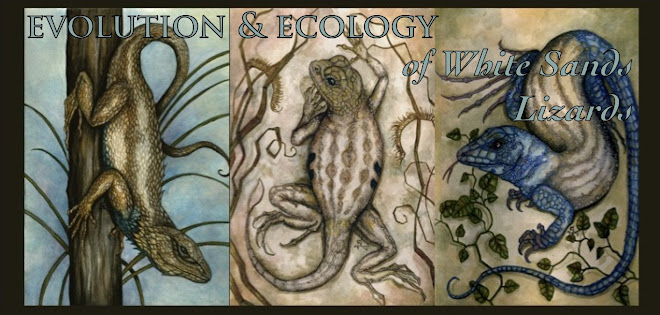Well, I've certainly let the time and events build up since I last wrote. I'll therefore be brief and let the photographs speak the stories!
 |
| Insect and spider hunting with the whole team. |
 |
| The night brings out the very small... "Wind Scorpion" consuming a less-interesting dipterid |
 |
| ... and the very large full moon. |
 |
| "Dark" melanic conspecific of the same species of little striped whiptail (Aspidoscelis inornata) also found in White Sands. |
On our way to the first ever White Sands Symposium in Las Cruces, we stopped by our "dark soils" site at the Jornada Long Term Ecological Research Station. I've collected melanic (dark pigmented) lizards from this site in years past, which are conspecific (depending on who you ask) with the blanched species found within White Sands. This year, we glimpsed some long-nosed leopard lizards, many dark little striped whiptails, one dark lesser earless lizard, and several side blotched lizards.
 |
| Requisite jumping-with-noose-poles photo at Jornada. |
 |
| White Sands Symposium at Las Cruces, NM |
Take care followers! And goodnight creatures of the dark!
-S. Des Roches

gypsum dunes- how unique is that?? Are there even any other gypsum dunes in the entire world? Does the softness of the gypsum effect the lizards differently than quartz sands?
ReplyDeleteHi Llyn! There are some gypsum dunes in Quatro Cienegas in Mexico... basically south of White Sands.
ReplyDeleteWhite Sands IS the largest gypsum dune field in the world, however. Certainly it effects the lizards. For one, gypsum does not heat up as quickly as regular quartz sand so lizards, as ectotherms (=cold blooded), are likely largely influenced by this in terms of their behaviour. Surely other aspects of their biology are also influenced... the lesser earless lizard burrows, for example. And another thing! Gypsum dissolves in water!
http://en.wikipedia.org/wiki/Cuatro_Ci%C3%A9negas.